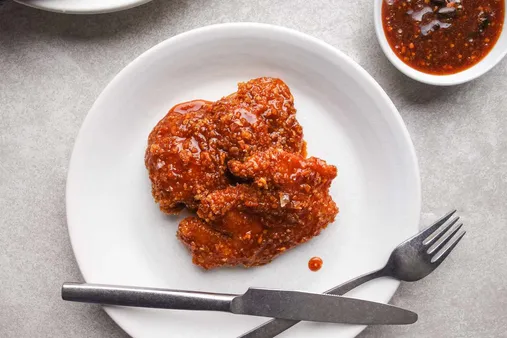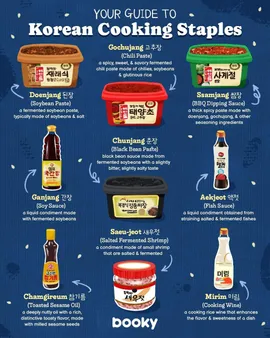Table of Contents
Embark on a culinary journey with Tauhuichiban.com and discover "The tips and tricks for mastering Korean sauces". These sauces are the heart and soul of Korean cuisine, adding depth, flavor, and authenticity to every dish. In this comprehensive guide, we'll unveil the secrets to creating mouthwatering sauces that will transform your home cooking into an extraordinary experience. From understanding the nuances of Korean ingredients to mastering thickening techniques and balancing flavors, we'll empower you with the knowledge to elevate your culinary creations and impress your family and friends.

The Tips and Tricks for Mastering Korean Sauces
I. Mastering Korean Sauces: Essential Tips and Tricks
Korean sauces are a fundamental aspect of Korean cuisine, adding layers of flavor and complexity to dishes. Mastering these sauces is essential for creating authentic Korean meals. Here are some essential tips and tricks to elevate your Korean sauce-making skills:
1. Understand the Foundation of Korean Sauces: Korean sauces are typically made with a base of soy sauce, gochujang (Korean chili paste), or doenjang (Korean soybean paste). These ingredients provide the backbone of flavor and can be combined in various proportions to create different sauces.
2. Balance Flavors: Korean sauces strive for a harmonious balance of flavors. Sweetness from honey or sugar, acidity from vinegar or citrus, and umami from fermented ingredients like gochujang or doenjang are carefully combined to create a complex and satisfying taste.
3. Thicken and Season: To achieve the desired consistency, Korean sauces often use thickeners like cornstarch or potato starch. Seasonings such as garlic, ginger, sesame oil, and green onions add depth and aroma to the sauces.
4. Enhance Flavor with Aromatics: Aromatics like garlic, ginger, and green onions are essential for building flavor in Korean sauces. These ingredients are often sautéed or infused in oil to release their aromatic compounds.
5. Experiment with Variations: Korean sauces offer endless possibilities for experimentation. Try adding different ingredients like fruit, vegetables, or herbs to create unique and personalized sauces.
Sauce | Base | Key Ingredients |
|---|---|---|
Soy Sauce | Soybeans | Water, salt |
Gochujang | Red chili powder | Glutinous rice, soybeans, salt |
Doenjang | Soybeans | Salt, water |
6. Pair Sauces with Dishes: Different Korean sauces complement specific dishes. For example, soy sauce is commonly used for marinades and dipping sauces, while gochujang-based sauces are ideal for spicy stews and stir-fries.
7. Store Sauces Properly: Korean sauces can be stored in airtight containers in the refrigerator for several days or frozen for longer storage. Thaw frozen sauces in the refrigerator before using.
Mastering Korean sauces is a culinary journey that requires practice and experimentation. By following these tips and tricks, you can create authentic and flavorful Korean sauces that will elevate your cooking to the next level.
II. The Art of Balancing Flavors: A Guide to Korean Sauce Harmony
Korean cuisine is renowned for its bold and vibrant flavors, and sauces play a crucial role in achieving this culinary symphony. Mastering the art of balancing flavors in Korean sauces requires an understanding of the essential ingredients and techniques used to create harmony and depth.
The foundation of Korean sauces lies in a delicate balance of sweet, salty, sour, and spicy elements. Soy sauce, a staple ingredient, provides a salty base, while sugar or honey adds sweetness. Vinegar or citrus juices introduce sourness, and gochujang (Korean chili paste) or gochugaru (Korean chili powder) bring heat. By carefully adjusting the proportions of these ingredients, chefs can create sauces that tantalize the taste buds.
Ingredient | Flavor Profile |
|---|---|
Soy Sauce | Salty, umami |
Sugar/Honey | Sweet |
Vinegar/Citrus Juices | Sour |
Gochujang/Gochugaru | Spicy, savory |
Beyond the core ingredients, a variety of aromatics and seasonings enhance the complexity of Korean sauces. Garlic, ginger, and green onions provide a fragrant base, while sesame oil adds a nutty richness. Fermented ingredients like doenjang (soybean paste) or jeotgal (salted seafood) contribute umami and depth of flavor.
Techniques such as marinating, braising, and stir-frying play a vital role in developing the flavors of Korean sauces. Marinating meats or vegetables in a flavorful sauce allows them to absorb the seasonings and become more tender. Braising involves cooking ingredients in a flavorful liquid over low heat, resulting in tender and succulent dishes. Stir-frying sauces are typically thickened with cornstarch or potato starch, creating a glossy and flavorful coating for ingredients.
Mastering the art of balancing flavors in Korean sauces is a culinary journey that requires patience and experimentation. By understanding the essential ingredients, techniques, and principles of flavor harmony, you can create authentic and delicious Korean dishes that will tantalize your taste buds and transport you to the vibrant streets of ul.
Here are some tips for balancing flavors in Korean sauces:
- Start with a small amount of each ingredient and gradually adjust to taste.
- Use a variety of ingredients to create a complex flavor profile.
- Don't be afraid to experiment with different combinations of ingredients.
- Pay attention to the texture of your sauce and adjust the consistency as needed.
- Taste your sauce as you go and make adjustments until you're happy with the flavor.
With practice and a little bit of patience, you'll be able to master the art of balancing flavors in Korean sauces and create delicious dishes that will impress your family and friends.

The Art of Balancing Flavors: A Guide to Korean Sauce Harmony
III. Techniques for Achieving Perfect Consistency: From Thin to Thick
Whether you're a seasoned chef or a home cook, achieving the perfect consistency for your Korean sauces is crucial. Mastering this technique will elevate your dishes and impress your taste buds.
To achieve a thin, watery consistency, start with a small amount of liquid and gradually add more while whisking constantly. This method ensures a smooth, even texture. For a thicker consistency, whisk in a cornstarch slurry, a mixture of cornstarch and water, which creates a glossy and velvety texture. Experiment with different ratios of cornstarch to water to achieve your desired thickness.
| **Consistency** | **Technique** ||---|---|| Thin | Gradually add liquid while whisking || Medium | Whisk in a small amount of cornstarch slurry || Thick | Whisk in a larger amount of cornstarch slurry |
Tips for Achieving Perfect Consistency:
- Use a whisk to prevent lumps and ensure even distribution.
- Heat the liquid over medium heat to allow the cornstarch slurry to thicken properly.
- Bring the sauce to a simmer and cook until it reaches your desired thickness.
- If the sauce becomes too thick, whisk in a little bit of water or liquid to thin it out.
- If the sauce is not thick enough, add more cornstarch slurry.
Perfecting the consistency of your Korean sauces is a culinary skill that will elevate your cooking. By following these techniques and experimenting with different ingredients, you can create a symphony of flavors that will delight any palate.

Techniques for Achieving Perfect Consistency: From Thin to Thick
IV. Exploring the Nuances of Korean Sauces: A Culinary Journey
Korean sauces are a fundamental aspect of the country's cuisine, adding layers of flavor and complexity to dishes. From the spicy and savory gochujang to the sweet and tangy ganjang, each sauce has a unique character that enhances the flavors of the ingredients it accompanies. In this article, we will delve into the world of Korean sauces, exploring their essential ingredients, techniques for thickening and seasoning, and tips for enhancing flavor and complexity. We will also provide a guide to pairing Korean sauces with various dishes, ensuring that you can create authentic and delicious Korean meals at home.
Sauce | Main Ingredients | Flavor Profile |
|---|---|---|
Gochujang | Red chili powder, glutinous rice, soybeans, salt | Spicy, savory, slightly sweet |
Ganjang | Soybeans, salt, water | Salty, slightly sweet, umami |
Doenjang | Soybeans, salt, water | Salty, savory, earthy |
Ssamjang | Gochujang, doenjang, sesame oil, garlic, onion | Spicy, savory, nutty |
Kochujang | Red chili powder, glutinous rice, soybeans, salt, sugar | Sweet, spicy, savory |
To thicken Korean sauces, various techniques can be employed. One common method is to use cornstarch or potato starch, which can be mixed with a small amount of water to create a slurry. This slurry is then added to the sauce while it is simmering, and it will gradually thicken as it cooks. Another method is to reduce the sauce by simmering it over low heat. As the water evaporates, the sauce will become thicker and more concentrated. Seasoning Korean sauces is also an important step in achieving the desired flavor profile. Common seasonings include garlic, ginger, onion, sesame oil, and rice vinegar. These ingredients can be added to the sauce while it is simmering, or they can be used as a garnish before serving.
- Gochujang is a versatile sauce that can be used as a marinade, dipping sauce, or cooking sauce. It is commonly used in dishes such as bibimbap, tteokbokki, and kimchi.
- Ganjang is a staple ingredient in Korean cuisine and is used as a dipping sauce for grilled meats, vegetables, and seafood. It can also be used as a seasoning in soups, stews, and stir-fries.
- Doenjang is a fermented soybean paste that is used as a base for many Korean soups and stews. It has a strong, earthy flavor that adds depth and complexity to dishes.
- Ssamjang is a thick, spicy paste that is used as a dipping sauce for grilled meats and vegetables. It is made from a combination of gochujang, doenjang, sesame oil, garlic, and onion.
- Kochujang is a sweet and spicy sauce that is used as a marinade, dipping sauce, or cooking sauce. It is commonly used in dishes such as bulgogi, japchae, and kimchi.
Pairing Korean sauces with various dishes is essential for creating balanced and flavorful meals. Here are some guidelines to help you get started:
- Spicy sauces, such as gochujang and kochujang, pair well with grilled meats, vegetables, and seafood.
- Salty sauces, such as ganjang and doenjang, pair well with soups, stews, and stir-fries.
- Sweet sauces, such as ssamjang, pair well with grilled meats and vegetables.
By understanding the different types of Korean sauces, their flavor profiles, and how to use them, you can elevate your Korean cooking skills and create authentic and delicious dishes that will impress your family and friends.

Exploring the Nuances of Korean Sauces: A Culinary Journey
V. Conclusion
Mastering Korean sauces is a culinary journey that unveils the authentic flavors of this vibrant cuisine. By embracing the foundation, experimenting with ingredients, and honing your techniques, you can transform ordinary dishes into extraordinary experiences. Remember, patience and practice are key to achieving the perfect balance and depth of flavor. As you continue your culinary exploration, don't hesitate to experiment with different combinations and discover new ways to showcase the versatility of Korean sauces. Your taste buds will thank you for it!